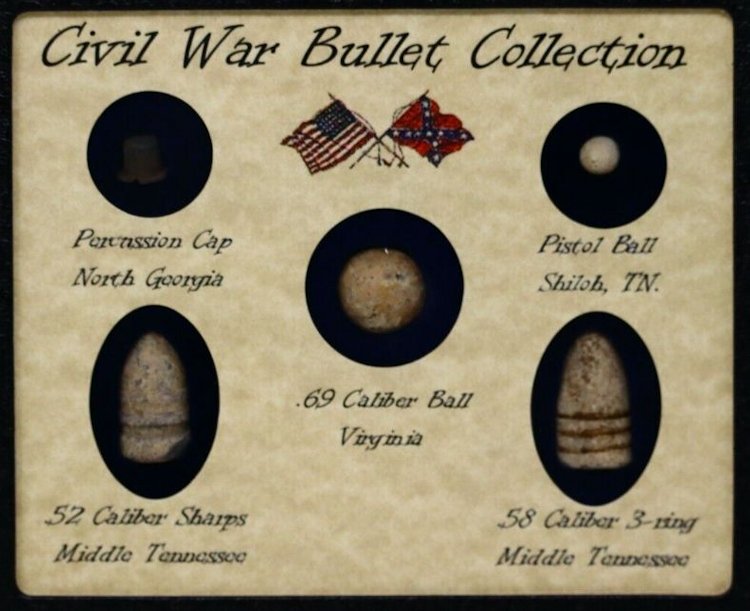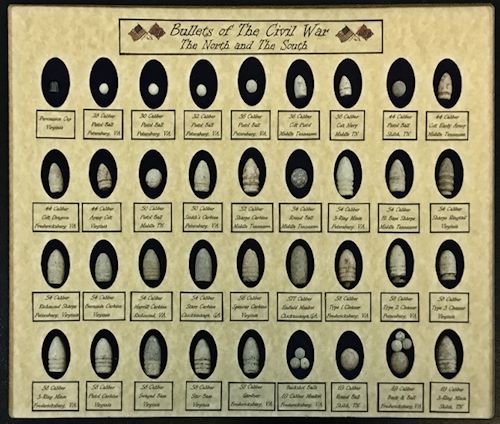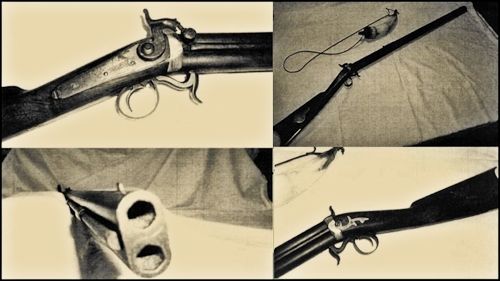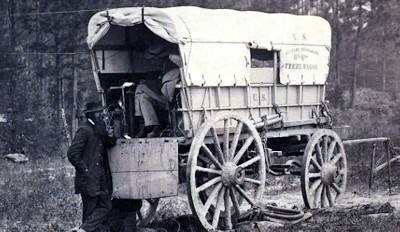Clark Co., Wisconsin Civil War
*********************************************************************************
Artifacts & Weapons from the Civil War
[Clark Co., WI Home] [ Veteran's Library Home]
Bullet Collection



(Pictured above--Shot bullet from the battle of Gettysburg)

[Enlarge]
Rossmans Civil War Musket

[Enlarge]
[Clark Co., WI Home] [ Veteran's Library Home]
Confederate Canister Shot & 3-Ring Miniballs recovered in Appomattox VA



[Enlarge]
The First Car Phone Was The Civil War
Telegraph Wagon
This Information appeared in our Sept., 2023 Anagram

A TELEGRAPH BATTERY-WAGON
NEAR PETERSBURG, JUNE 1864
The operator in this photo is receiving a telegraphic message, writing at his
little table in the wagon as the machine clicks off. Each battery-wagon was
equipped with such an operator's table and attached instruments. A portable
battery of one hundred cells furnished the electric current. No feature of the
Army of the Potomac contributed more to its success than the field telegraph.
Guided by its young chief A.H. Caldwell, its lines bound the corps together like
a perfect nervous system, and kept the great controlling head in touch with all
its parts. Not until Grant cut loose from Washington and started from Brandy
Station for Richmond was its full power tested. Two operators and a few
orderlies accompanied each wagon, and the army crossed the Rapidan with the
telegraph line going up at the rate of two miles an hour. At no time after that
did any corps lose direct communication with the commanding general. At
Spotsylvania the Second Corps, at sundown, swung round from the extreme right in
the rear of the main body to the left. Ewell saw the movement, and advanced
toward the exposed position; but the telegraph signaled the danger, and troops
on the double-quick covered the gap before the alert Confederate general could
assault the Union lines. THE MILITARY~TELEGRAPH SERVICE, By A. W.
GREELY
Major-General, United States Army
*****************************************
The actual vehicles that are the ancestors of all our on-line cars were called
Telegraph Battery Wagons. Just like the cell phone of today, most of the
internal volume was consumed by battery needs. Open your cell phone and you'll
find that most of the interior is packed with a form-fitting rechargeable
battery. Open one of these telegraph wagons, and you'll find the same thing is
true, essentially. Almost all of the wagon was packed with batteries.
Now, keep in mind these aren't the nice, clean, not-scar-you-with-acids
batteries we enjoy today. These were likely something closer to a crapload of
acid-filled jars. Common telegraph batteries of the era were Daniell Cells,
which were, too keep things exciting in a moving wagon, open-topped jars.
Closed-jar lead-acid Leclanché batteries, one of the first rechargable battery
cells, didn't come around until after the war in 1866.
These Daniell Cell batteries made about 1.1 V each, and the number of batteries
needed to send a signal a given distance varied on the type of wire it was
sending over. Some estimates give 2V per 20 miles, some much more. Even if we
estimate 1V per 10 miles, that's a lot of bulky, leaky batteries to get a useful
distance. An average load of batteries for a telegraph battery wagon seems to
have been about 100 cells.
In addition to being packed with battery cells, these wagons also had a small
area with a telegraph key and a place for a person, very often a civilian
contractor, to operate it. This is the key part that makes these clunky wagons
so significant. Telegraphs were the first commercial/mainstream use of anything
electrical at all, and the placement of a telegraph set in a wagon makes this
combination the first electric component in any vehicle, ever. Unless someone
finds evidence of a mobile electroplating setup in an ancient Persian chariot,
at least.
Since I'm already pretty wildly diverging from our usual motor-driven fare, I
may as well keep going, because there's some interesting stuff here. These
mobile telegraph wagons would link one another with miles and miles of wire, and
then at other points link into the larger established telegraph network. This
would allow both inter-camp instant communication and also communication with
Washington (or a bit less commonly, Richmond).
Since telegraphs use just one wire with simple coded pulses sent over them, it
was very easy to connect these lines — when you have only one wire to connect,
it's tricky to get it wrong. That also means the Civil was was the birth of the
first cyberwarfare, cyberespionage, and hacking. I'm taking some liberties on
the use of "cyber" but you can argue that a virtual electrical, Morse-coded
world was made by the telegraph network, and that's roughly analogous to the
internet.
Hacking/eavesdropping lines was pretty easy. You'd send some soldier/telegrapher
out to a quiet section of telegraph line, and they'd splice in their own wire
linking to their own telegraph sounder. That's it. To help combat this, the
Union and Confederate armies used two tactics: shoot anyone they saw doing this,
and codes.
These codes are especially interesting. According to the Civil War Signals site,
an effective Union cipher was to use nonsense words mixed in the real message,
and key words would signal a matrix layout for the words, and the order the
words were to be read and/or ignored. The resulting encoded messages sound like
hilarious dada-poetry:
Washington, D.C.,July 15,1863
A.H. Caldwell, Cipher-operator, General Mead's Headquarters:
Blonde bless of who no optic to get an impression I madison-square Brown cammer
Toby ax the have turnip me Harry bitch rustle silk adrian counsel locust you
another only of children serenade flea Knox country for wood that awl ties get
hound who was war him suicide on for was please village large bat Bunyan give
sigh incubus heavy Norris on trammeled cat knit striven without Madrid quail
upright martyr Stewart man much bear since ass skeleton tell the oppressing
Tyler monkey.
Bates.
Except from Jason Torchinsky, 18 Jan 2013
